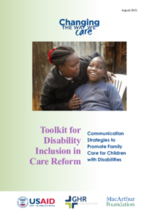Raising awareness of disability, disability inclusion and the rights of children with disabilities are key parts of the care reform processes in all countries. Through influencing those who currently operate, fund, support or develop policies around the residential care facilities (sometimes called institutions, children’s homes or orphanages) we can ensure that children with disabilities are not left behind. The policy makers with responsibility for systems of care and protection, providers of services for children, families and communities all may stigmatize or discriminate against families of children with disabilities. They may, with purpose or unconsciously, not include children with different abilities in their work and daily lives. With a cohesive and well-planned communication strategy, much can be achieved toward awareness, behavior change and the inclusivity of care services for all children.
Communication refers to the delivery and reception of information or messages to a target audience; whilst awareness-raising is a process that informs and educates on a topic or issue with the intention of influencing their attitudes, behaviors and beliefs and advocacy is the process of influencing decisions, actions or broader change. Within awareness raising and advocacy, communication that is strategic and planned, with clear objectives and actions leads to behavior or policy change. Communication without a strategy is unlikely to achieve its aims.
Advocacy is a continuous process which leads to positive change in attitudes, behavior and relationships within the family, workplace, community, state and society (i.e., all social institutions)
- The Action Guide for Advocacy and Citizen Participation
In the case of this document, the awareness raising and advocacy is on behalf of or to benefit children with disabilities—many of whom may struggle to communicate because of their disability or whose voices are not heard—and because adults, systems and services often do not consider the opinions of children and children with disabilities are often left behind in changing or improving systems of care. Wherever possible, include children’s own participation in raising awareness and advocacy efforts. This can have a very powerful influence on key actors and decision-makers. Giving adults with disabilities and their families a platform to share their first-hand experiences is also crucial.
With communication, a story is being told. With awareness raising education and information is shared. With advocacy, the target audience is being moved toward action. It is important to understand the difference.

